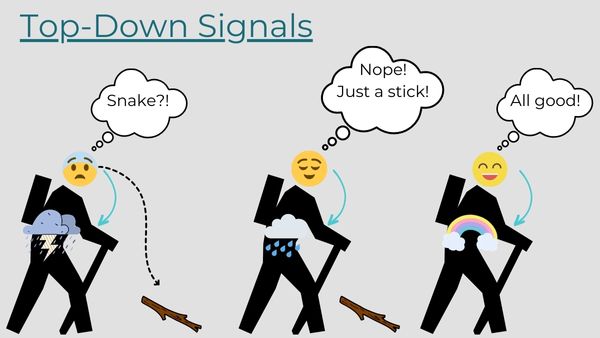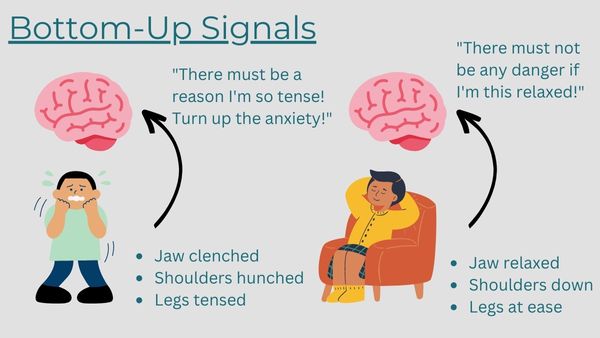You’re standing at the edge of a cliff, gazing down into the abyss below. Your palms are sweaty, your knees are weak, and an overwhelming urge to step back surges through you. What if a simple shift in how you hold yourself could dramatically turn down the volume on your anxiety? Welcome to Bottom-Up signals.

In the pursuit of improved mental health, many strategies focus on changing the way you think in order to change the way you feel. However, a lesser-known aspect of this dynamic is the signals that your body sends to your brain, known as Bottom-Up signals.
These signals can significantly impact your mental state, including contributing to anxiety. Understanding and harnessing these signals can empower you to manage your anxiety more effectively.
Table of Contents
The Standard Approach: “Top-Down” Signals
As you’re hiking, you see a stick that looks very snake-like. You do a double take, but your brain sends a message to your body that it doesn’t need to run away or dump a bunch of adrenaline into your system, because that is a stick and not a snake. You feel calm and just keep walking down the path.
You feel nervous about a test. Your palms are sweaty, your stomach is in knots, and you’re feeling ready to bolt. But then you remind yourself that you studied as much as you could and your friend told you this teacher is an easy grader and then start to feel a bit better. Your stomach starts to relax, your palms start to dry, and you no longer feel the need to run.
This kind of approach demonstrates “top-down” signals, i.e., your brain sends signals down to your body, which then affects how you are feeling. These signals create a feedback loop that can help you feel calmer (or not get anxious in the first place). This dynamic is often addressed in therapy by attempting to change your thinking to be more positive or realistic.

The Two-Way Conversation Between Body and Mind
But the connection between your brain and your body isn’t a one-way street. Just as your brain sends signals down to your body, your body also sends signals up to your brain.
Our sense of touch is an obvious example of this. If you touch a hot stove, the sensors in your hand send a signal up to your brain (HOT!) and then your brain sends a message back down to your hand (MOVE!). Of course, all of this happens so fast, we don’t often think about or notice this “conversation” happening between our brain and our body.
Besides our sense of touch, there are actually lots of other ways that our body sends signals up to our brain that can have a significant effect on us.
Embodied Cognition or “Bottom-Up” Signals
Embodied cognition refers to the concept that “the mind is not only connected to the body but that the body influences the mind.” This phenomenon highlights the importance of Bottom-Up signals in shaping our mental state. For example, sitting or moving as if you feel a certain way can contribute to you feeling that way. This can affect your emotions in both positive and negative ways.
Harnessing Bottom-Up Signals
Research has uncovered several intriguing examples of bottom-up signals and their impact on our mental well-being:
- Smiling (even a fake smile!) increases happiness
- Sitting upright or standing in a confident pose can make you feel more confident
- Walking with your head down in a slouched position can contribute to depression
- Sitting with good posture can improve concentration
- Regularly systematically relaxing your muscles can alleviate anxiety and depression
All of these are powerful examples of this two-way connection between your mind and body.
Managing Anxiety through Bottom-Up Signals
Understanding how bottom-up signals contribute to anxiety can make a huge difference in managing your symptoms. When it comes to anxiety specifically, there are many different bottom-up signals that can make anxiety worse. Some common examples include:
- Fidgeting
- Wringing your hands
- Sitting with your body tensed up
- Gripping onto something tightly
- Pacing back and forth
- “Escaping” the situation
All of these responses to anxiety send a signal from your body to your brain that you must be acting that way for a reason. And that reason must be that there is actual danger. And if there is actual danger, then you should definitely feel anxious. These habits can reinforce your brain’s perception of danger, fueling the anxiety feedback loop.

Practical Techniques
The cool thing about knowing this, is that you can hack bottom-up signals to decrease your anxiety rather than increase it. If you are feeling nervous, simple adjustments in your body can help you start feeling less anxious.
| Try This: Do a quick scan from head to toe. Are your shoulders up by your ears? Drop them down. Is your jaw clenched? Move it around a bit and then let your jaw settle. Is your stomach in knots? Try to soften this area. Could you relax a bit more into your seat? Settle in. Let go of any tension in your legs or backside. See how that feels. Even small changes to your posture can help you feel more relaxed and confident. |
A more formal and thorough version of this exercise is called Progressive Muscle Relaxation. This is where you systematically relax each muscle group in your body one at a time. With regular practice, this can help reduce your overall anxiety.
Bottom-up signals are also why slow belly breathing can help you to reduce your anxiety. You are sending the message to your brain that everything must be okay or your breathing wouldn’t be so relaxed.
The Power of the Mind-Body Connection
By consciously adjusting your body language and posture, you can disrupt the negative feedback loop associated with your anxiety. If you act as if there is danger your body will believe you… And if you act as if there is NO danger your body will start to believe that, too.
As an anxiety therapist, I have seen many of my clients who suffer from panic attacks successfully use this technique to help prevent their anxiety from snowballing into panic. It won’t take the anxiety away completely, but it can make a big difference.
While bottom-up signals are not a cure-all, they can be an important piece of the puzzle that offers a tangible, accessible tool to complement other anxiety management strategies and improve your overall well-being.

As a reminder, this blog post is not intended as professional counseling or clinical advice. This article is meant to provide you with some helpful information about using Bottom-Up signals to manage your anxiety and improve your mental health. If you are struggling with your mental health, I encourage you to consider reaching out for additional support, professional or otherwise.

-Kristel Roper, LMFT, LPCC
Kristel Roper is a licensed psychotherapist offering therapy services to individuals in the Sacramento area. She specializes in therapy for anxiety and OCD and especially enjoys working with young women as they navigate the challenges of relationships, college, career, and beyond. If you have a question for Kristel or are interested in therapy for yourself or your loved one, feel free to reach out.
Photo by Quang Nguyen Vinh from Pexels
Photo by Martin Castro on Unsplash
